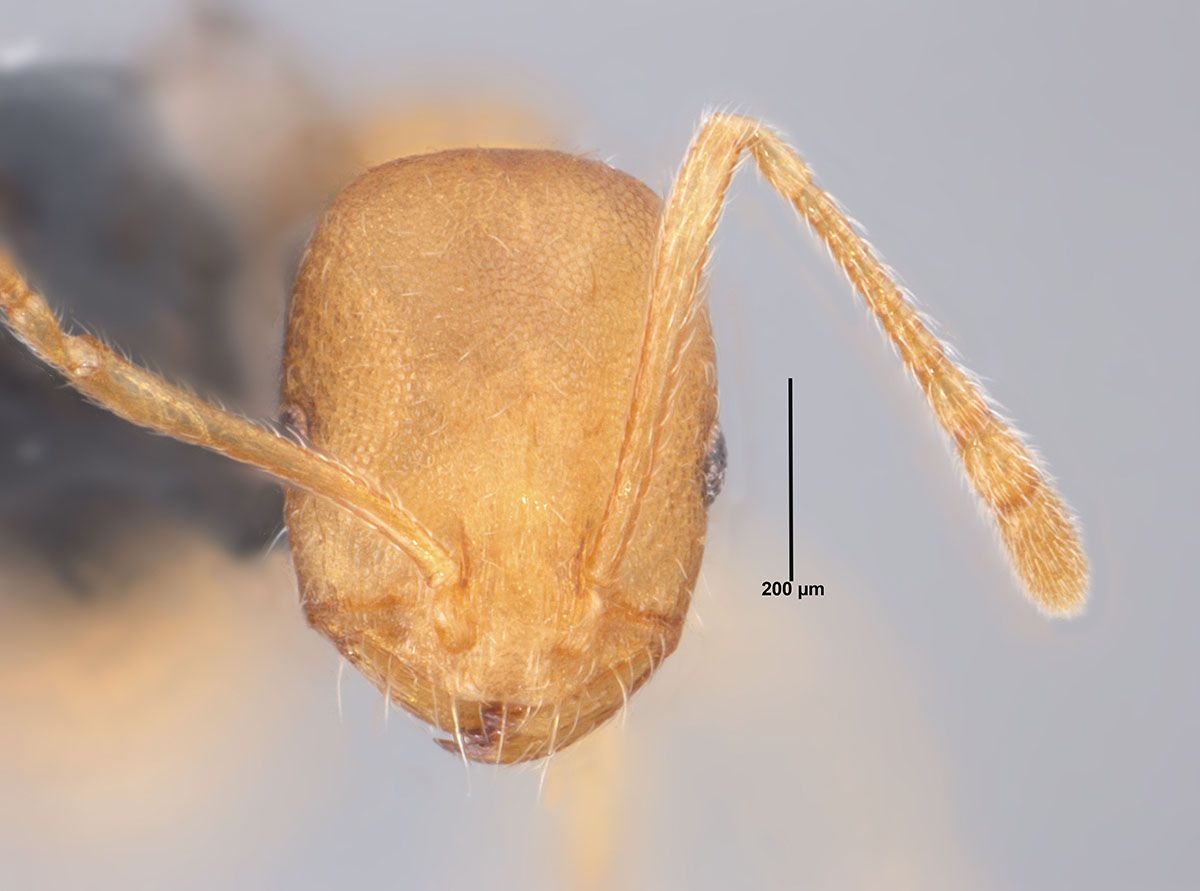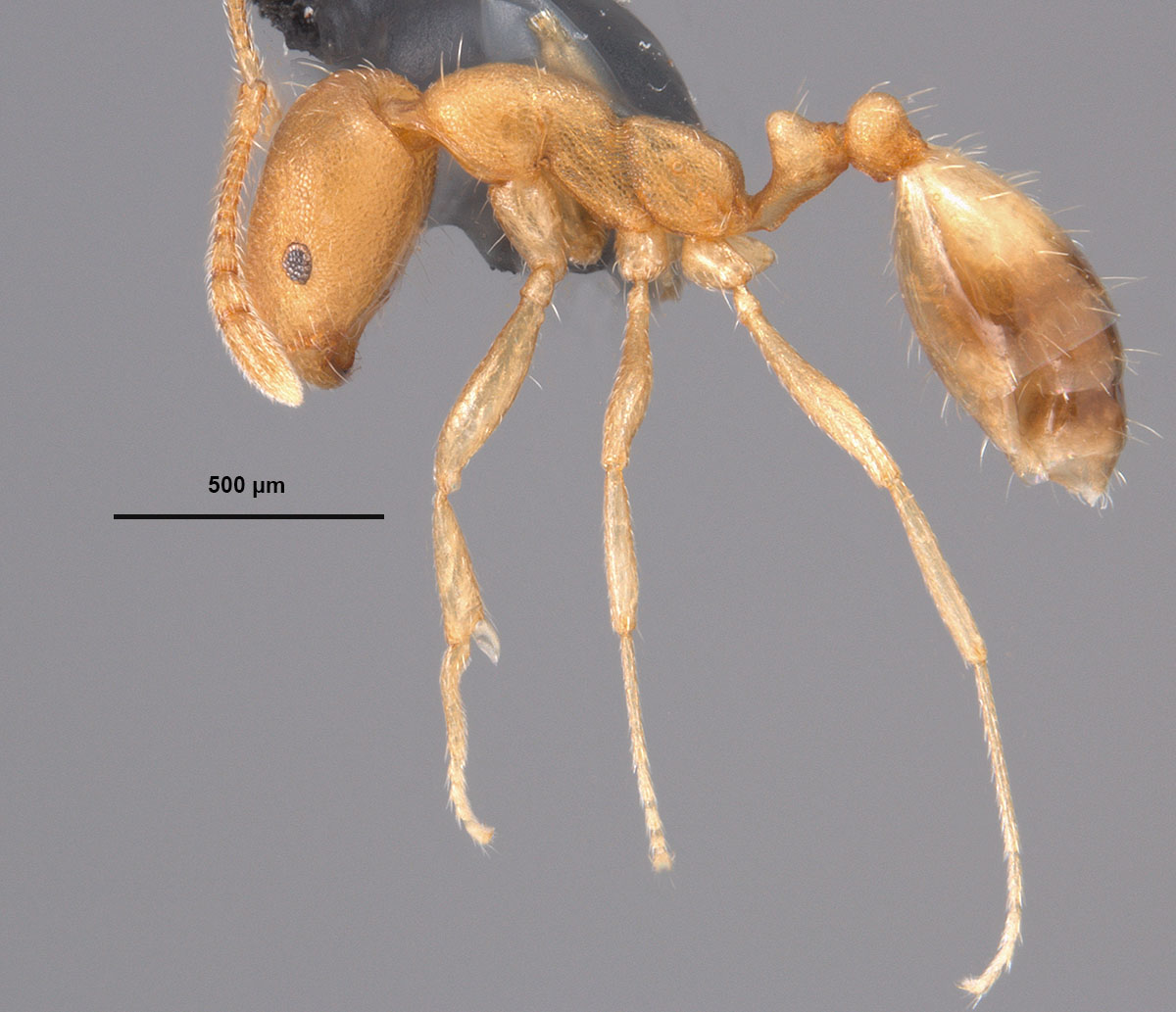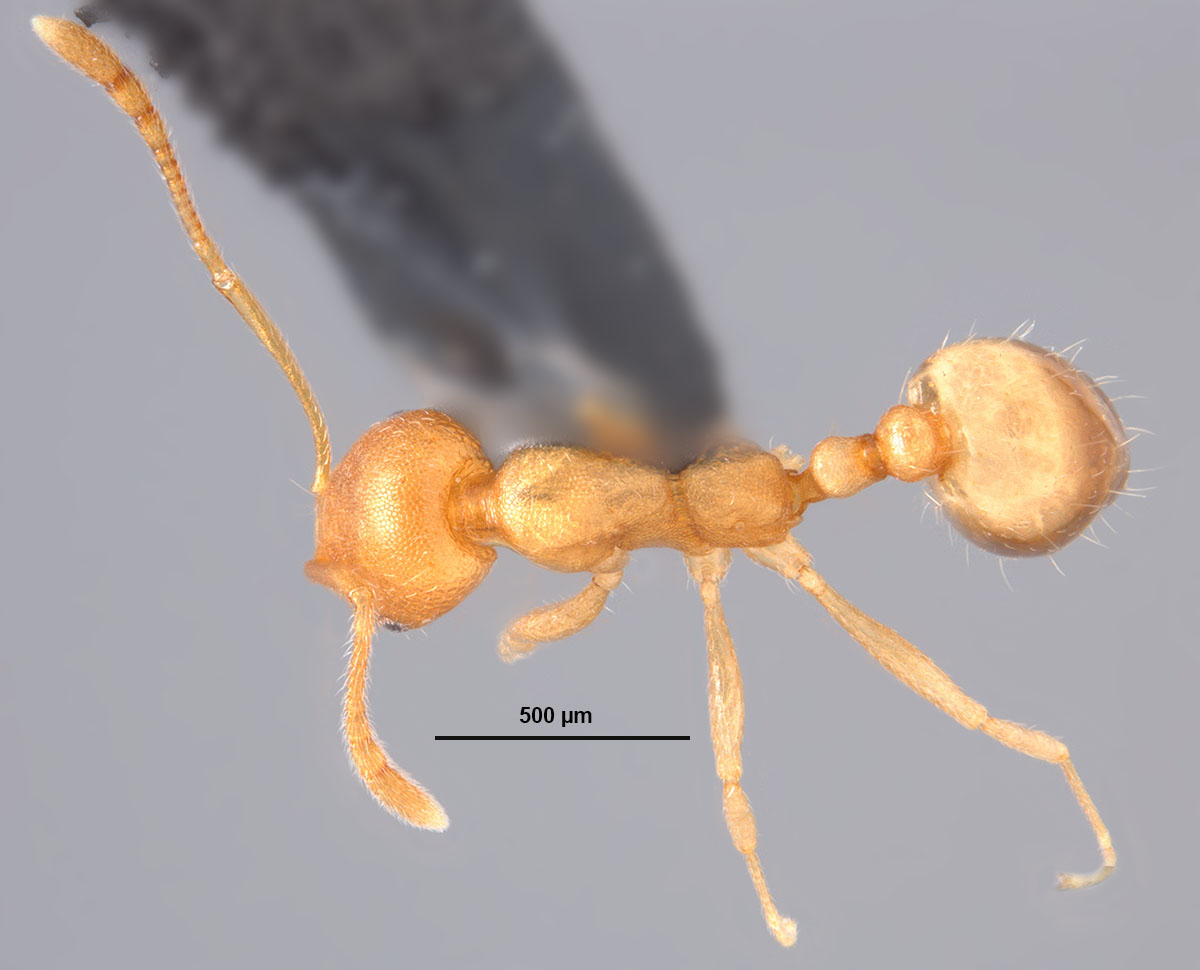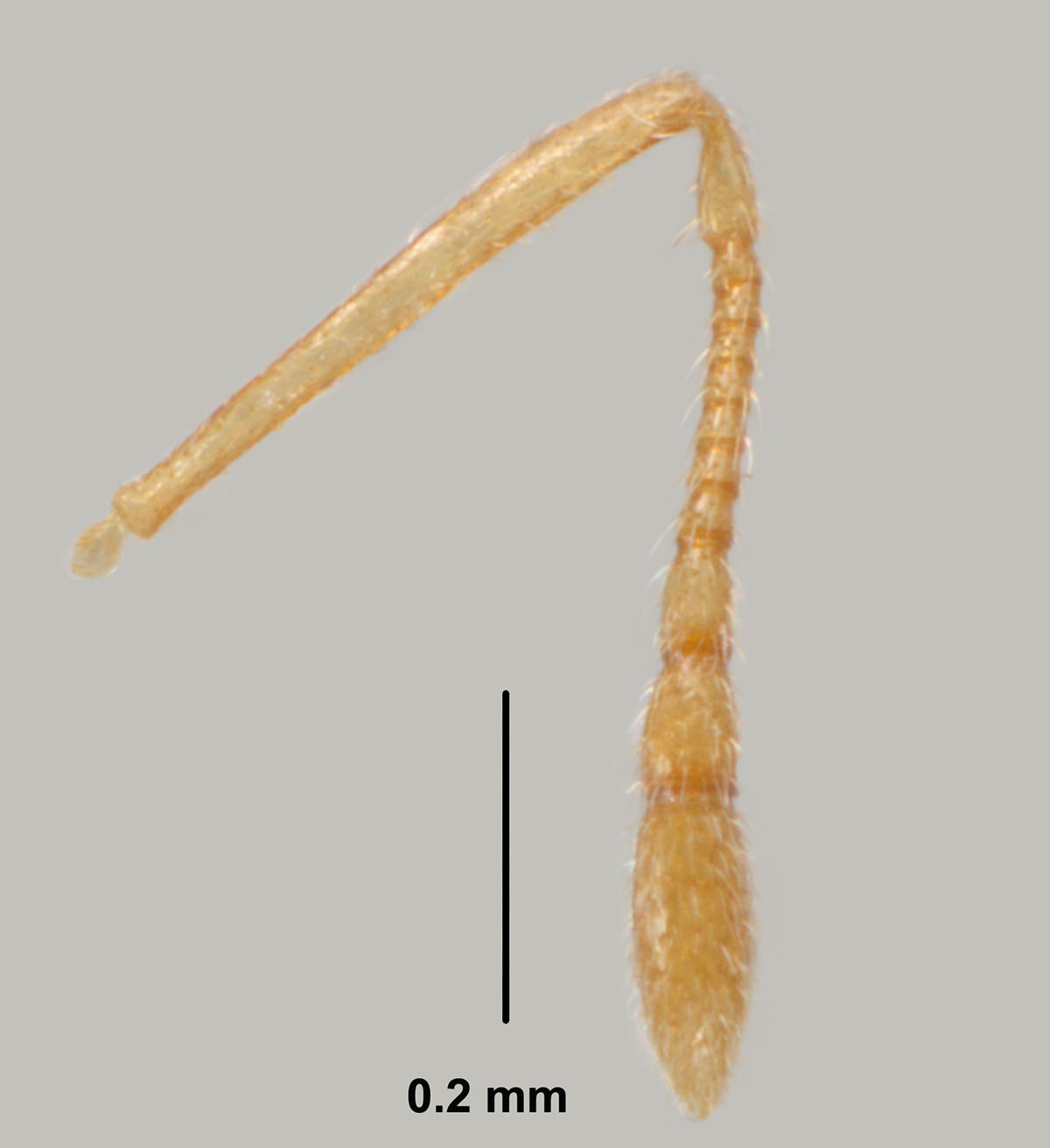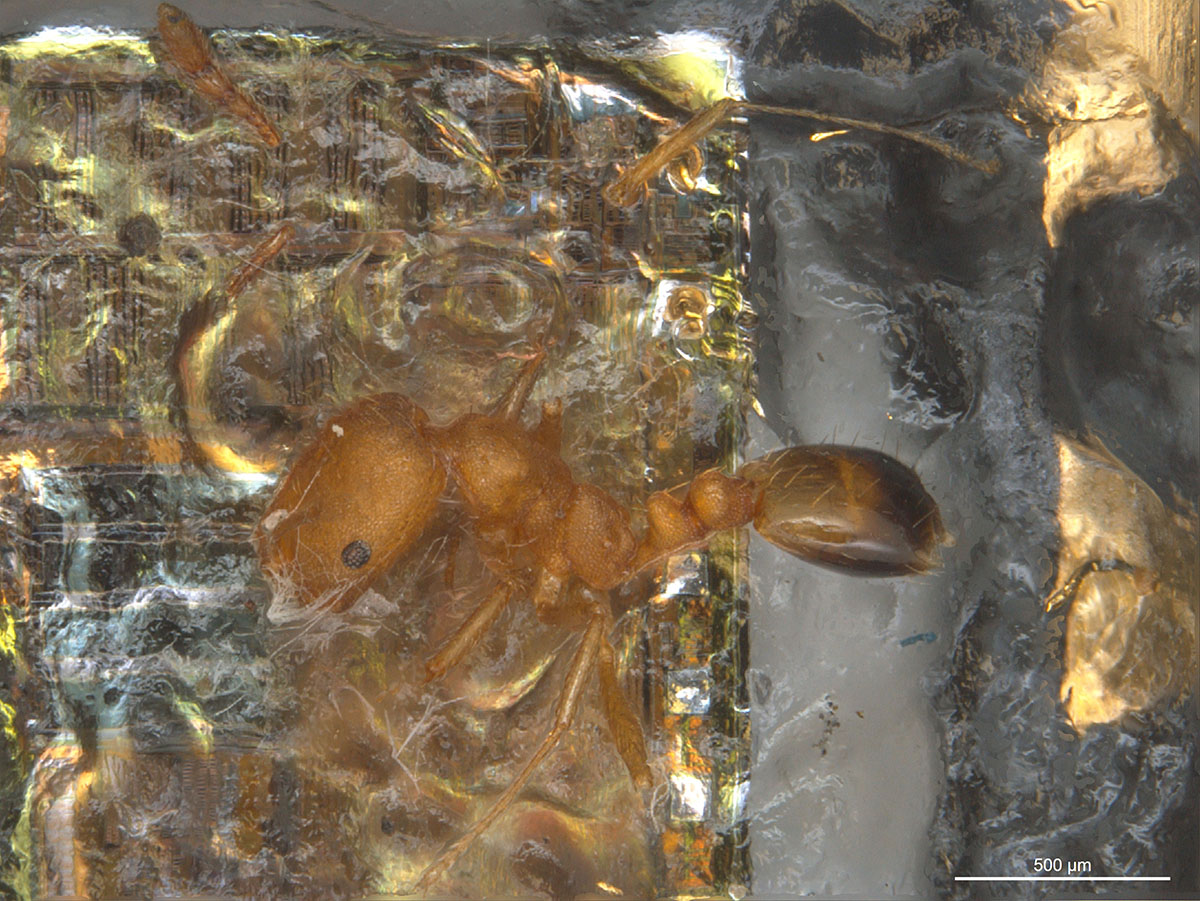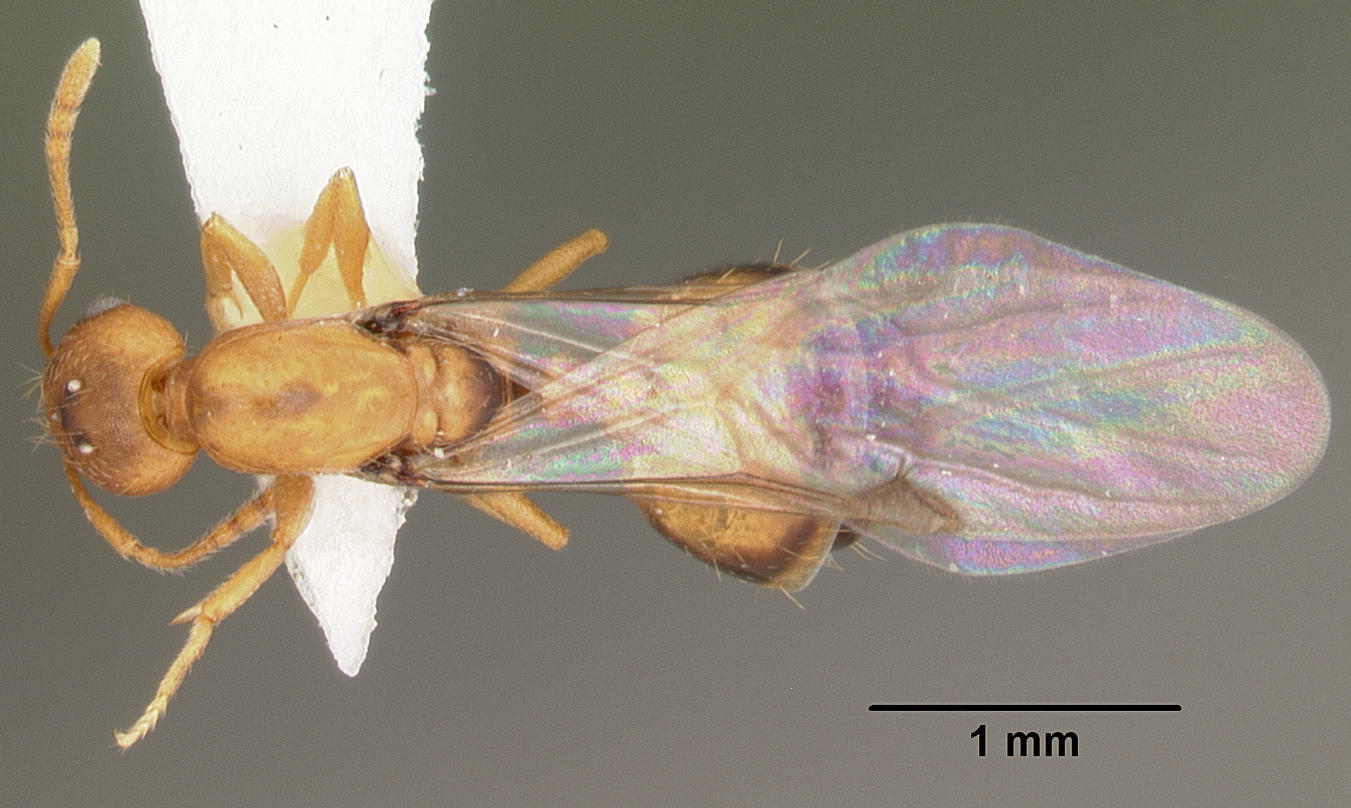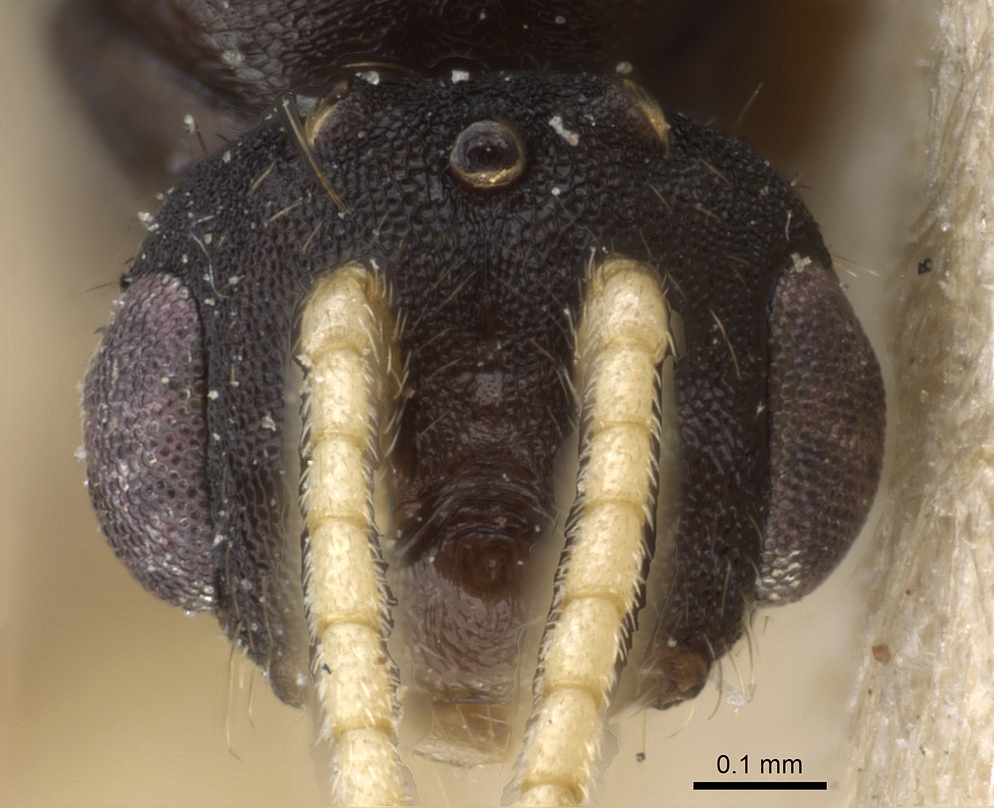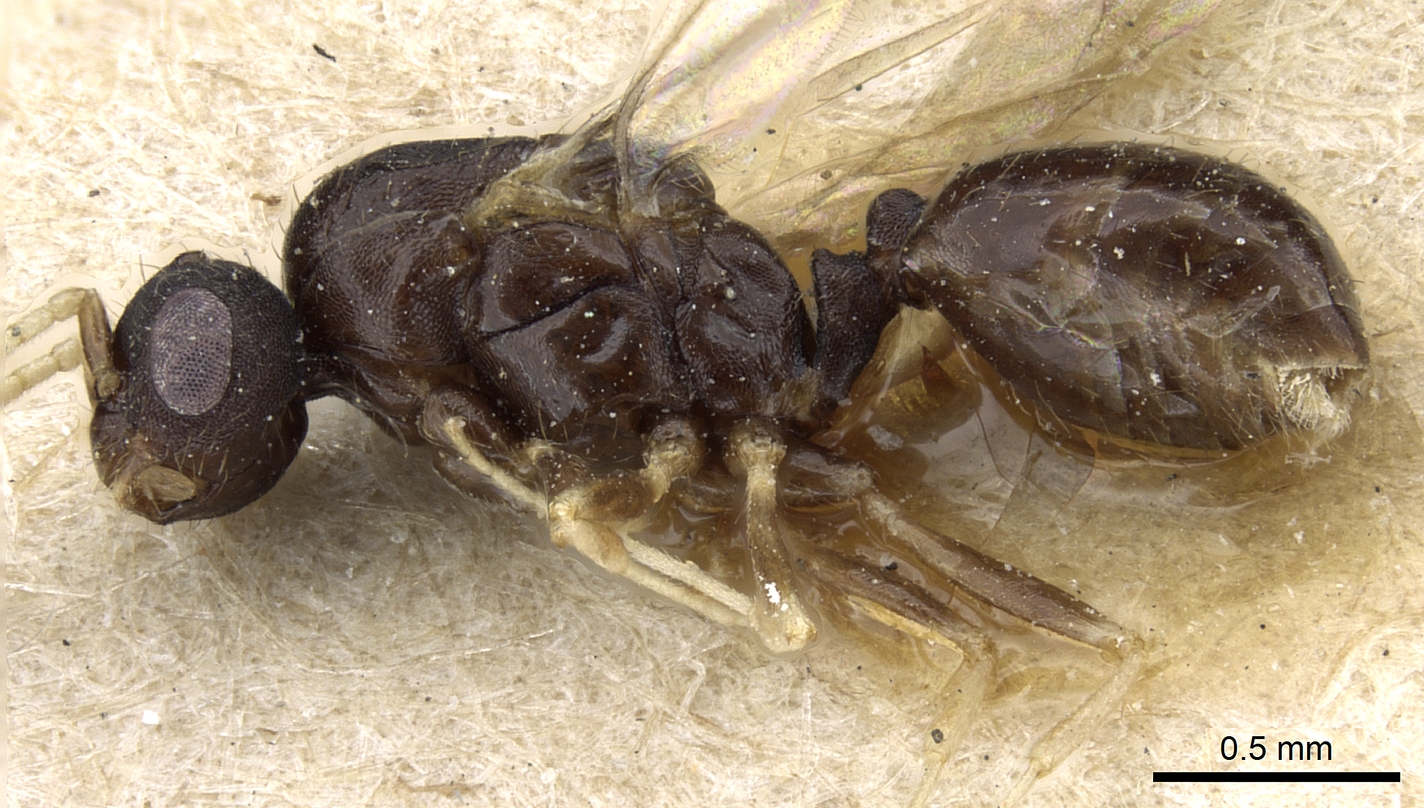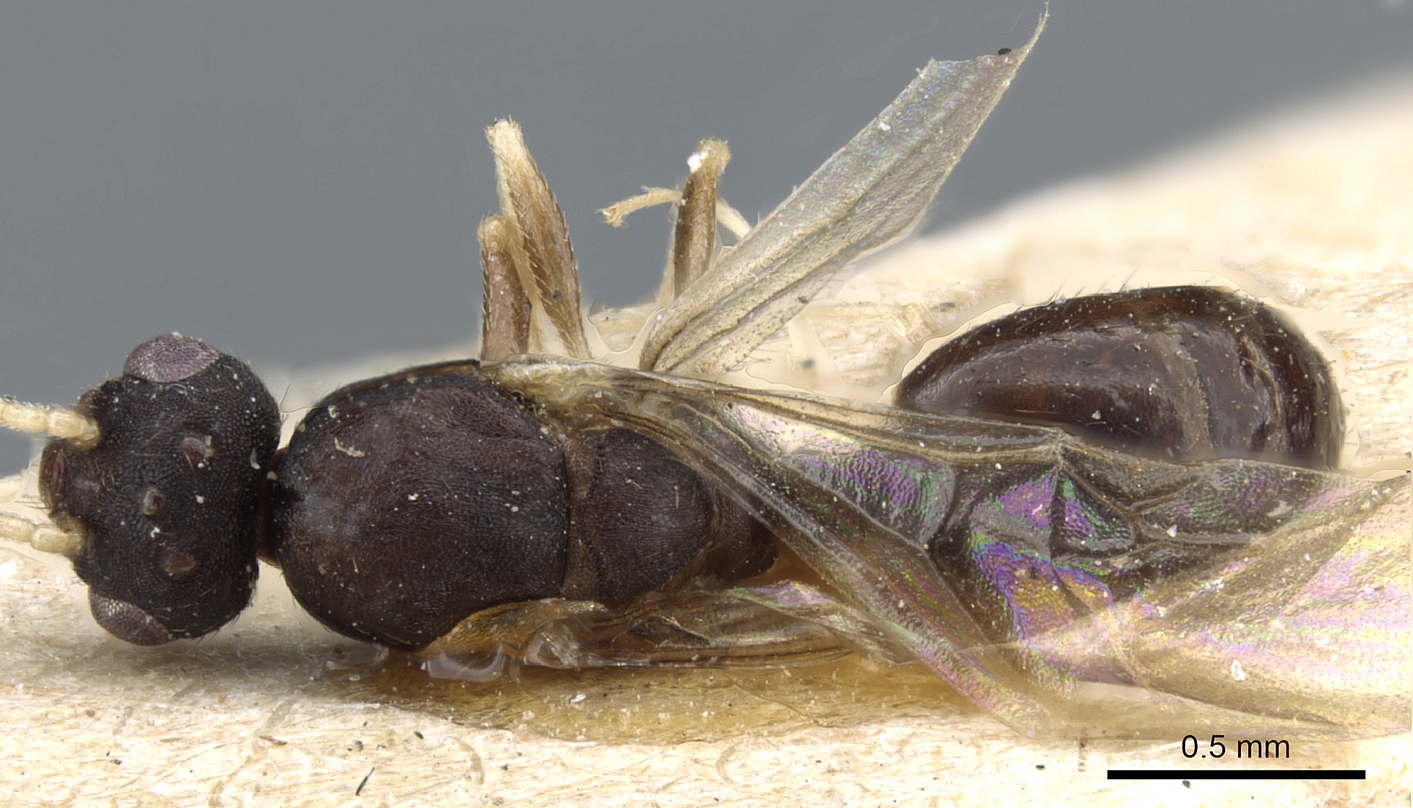Subfamily MYRMICINAE Pharoah ant Authors: Joe A. MacGown and Ryan J. Whitehouse |
||
Monomorium pharaonis, full face view of a worker (Lamar Co., AL) (photo by Ryan J. Whitehouse and Joe A. MacGown) |
Monomorium pharaonis, lateral view of a worker (Lamar Co., AL) (photo by Ryan J. Whitehouse and Joe A. MacGown) |
Monomorium pharaonis, dorsal view of a worker (Lamar Co., AL) (photo by Ryan J. Whitehouse and Joe A. MacGown) |
Monomorium pharaonis, antenna of a worker (Lamar Co., AL) (photo by Ryan J. Whitehouse and Joe A. MacGown) |
Monomorium pharaonis, worker in an airbag sensor of a car (photo by Joe A. MacGown) |
Monomorium pharaonis, worker in an airbag sensor of a car (photo by Joe A. MacGown) |
Monomorium pharaonis, full face view of a queen(Lake Co., FL) (photo courtesy of Antweb.org) |
Monomorium pharaonis, lateral view of a queen (Lake Co., FL) (photo courtesy of Antweb.org) |
Monomorium pharaonis, dorsal view of a queen (Lake Co., FL) (photo courtesy of Antweb.org) |
Monomorium pharaonis, full face view of a male (photo courtesy of Antweb.org) |
Monomorium pharaonis, lateral view of a male (photo courtesy of Antweb.org) |
Monomorium pharaonis, dorsal view of a male (photo courtesy of Antweb.org) |
Introduction Monomorium species can be identified by the presence of a petiole and post-petiole, 12 segmented antennae with a three segmented club, a raised medial area on the clypeus with fine longitudinal ridges and the lack of propodeal armament. Monomorium pharaonis (Linnaaeus), the pharaoh ant, is a tiny, yellow ant thought to be native to Africa. This species is a widespread tramp that occurs in many warm regions of the world. In temperate regions, including many parts of the US where it has been recorded, populations are in heated structures. Populations of this species in Mississippi are spotty, and most records are from indoor infestations. Taxonomic History Diagnosis Identification Queen: HL 0.66–-0.68mm, HW 0.62–0.63mm, SL 0.58–0.62mm PW 0.52–0.73mm (n=2, measurements from Heterick 2006). Head, mesosoma, waist and appendages orangish yellow to orangish brown with mesoscutum and legs sometimes lighter, and dark brownish black coloration at posterior region of mesoscutellum; and gaster with orangish yellow at base of first tergite and posterior edges of tergites, with remainder dark brown to brownish black. Head slightly longer than wide, with fine reticulation posteriorally, and becoming strialate below eye level, clypeus mostly smooth and shining, numerous (but not dense) short, slightly appressed setae present; ocelli present; eyes large and at approximate midline of head in side view; scape length slightly less than head length, with appressed setae; mandibles with strong apical tooth followed by three shorter teeth of about equal size. Mesosoma with fine reticulation/punctation, and dorsum with numerous, short, semi erect setae directed posteriorly; mesoscutum rounded anteriorly then flattened propodeum rounded. Waist with semi erect, slightly flexous setae directed posteriorly (setae longer than those on mesosomal dorsum); petiole conical in side view, pedunculate, rounded dorsally; postpetiole rounded in lateral and dorsal views. Male: Mayr described the male in 1865, but the only measurement he provided was that it was 3.0 mm long. The type was photographed by Antweb.org, and the following identification information was garnered from viewing those photos Head, mesosoma, waist, and gaster dark brownish black; antennnae pale yellow; coxae and tibia light brown; and femora pale yellow brown. Head slightly wider than long; entire head in full face view with foveolate sculpture; scattered short, semi erect setae present; eyes large, about half the head length; ocelli present, not noticeably elevated; antenna 13-segmented (including scapes); scape about length of funicular segments 2+3; mandibles present. Mesosoma with light foveolate sculpture except for mid region of mesopleuron, which is smoother, and shiny; mesosomal dorsum with scattered, short semi erect setae. Wings transparent; veins with little pigmentation, distal segments reduced to vestigial lines; m–cu absent; cu–a absent. Waist with a few, short, setae, directed posteriorly; petiolar peduncle thickened, node triangular in lateral view, strongly pitted with small fovea; petiole rounded in lateral and dorsal views, with numerous small foveo present. Gaster mostly lacking sculpture except for light reticultion on anterior region of first tergite, otherwise, smooth and shining; with scattered short, semi erect to erect setae, especially dorsally, and with a patch of more dense, longer setae on posterior sternites. Workers of Monomorium pharaonis can be identified by their minute size, yellowish brown color, light punctulate sculpture that does not obscure the shiny integument, 12-segmented antennae that terminates in a 3-segmented club, raised and narrowed clypeaus with a pair of fine longitudinal carinae, lack of propodeal spines, and sting. This species can be separated from other Monomorium species In the southeastern US by its light golden yellow color with brownish infuscation on the gaster. Species of thief ants in the related genus Solenopsis have 10-segmented antennae and lack fine sculpture. Biology and Economic Importance The pharoah ant is considered to be a serious house infesting ant species in the United States. Being omnivorous, any available food will sustain a colony, though they appear to prefer greasy, fatty foods and meats. This species may be found inhabiting houses, buildings and hospitals where they are often detected from their intricate foraging trails. They are especially considered a nuisance in hospitals where they are suspected to transmit pathogens. Pest Status Distribution Native Range: Thought to be Africa. Australian: Australia, Federated States of Micronesia, Fiji, French Polynesia, Guam, Hawaii, Indonesia, Kiribati, Marshall Islands, New Caledonia, New Guinea, New Zealand, Northern Mariana Islands, Samoa, Solomon Islands, Tokelau, Vanuatu (AntWeb.org). U.S. Distribution: AL, AR, AZ, CA, FL, GA, HI, IL, LA, MO, MS, NC, NM, OH, PA, SC, TN, TX, WA (AntWeb.org and MEM). Acknowledgments Literature Cited Atanassov, N.; Dlussky, G. M. 1992. Fauna of Bulgaria. Hymenoptera, Formicidae. [In Bulgarian.]. Fauna na Bûlgariya 22:1-310. Bolton, B. 1987. A review of the Solenopsis genus-group and revision of Afrotropical Monomorium Mayr (Hymenoptera: Formicidae). Bulletin of the British Museum (Natural History). Entomology 54:263-452. Donisthorpe, H. 1932. On the identity of Smith's types of Formicidae (Hymenoptera) collected by Alfred Russell Wallace in the Malay Archipelago, with descriptions of two new species. Annals and Magazine of Natural History (10)10:441-476. Emery, C. 1892 ("1891"). Note sinonimiche sulle formiche. Bullettino della Società Entomologica Italiana 23:159-167. Forel, A. 1891. Les Formicides. [part]. In: Grandidier, A. 1891. Histoire physique, naturelle, et politique de Madagascar. Volume XX. Histoire naturelle des Hyménoptères. Deuxième partie (28e fascicule). Paris: Hachette et Cie, v + 237 pp. Heterick, B. 2006. A revision of the Malagasy ants belonging to genus Monomorium Mayr, 1855 (Hymenoptera: Formicidae). Proceedings of the California Academy of Sciences (4)57:69-202. Imai, H. T. 1966. The chromosome observation techniques of ants and the chromosomes of Formicinae and Myrmicinae. Acta Hymenopterologica 2:119-131. Linnaeus, C. 1758. Systema naturae per regna tria naturae, secundum classes, ordines, genera, species, cum characteribus, differentiis, synonymis, locis. Tomus I. Editio decima, reformata. Holmiae [= Stockholm]: L. Salvii, 824 pp. Mayr, G. 1862. Myrmecologische Studien. Verhandlungen der Kaiserlich-Königlichen Zoologisch-Botanischen Gesellschaft in Wien 12:649-776. Mayr, G. 1886. Notizen über die Formiciden-Sammlung des British Museum in London. Verhandlungen der Kaiserlich-Königlichen Zoologisch-Botanischen Gesellschaft in Wien 36:353-368. Petralia, R. S.; Vinson, S. B. 1980 ("1979"). Comparative anatomy of the ventral region of ant larvae, and its relation to feeding behavior. Psyche (Cambridge) 86:375-394. Roger, J. 1862. Synonymische Bemerkungen. 1. Ueber Formiciden. Berliner Entomologische Zeitschrift 6:283-297. Smith, D. R. 1979. Superfamily Formicoidea. Pp. 1323-1467 in: Krombein, K. V.; Hurd, P. D.; Smith, D. R.; Burks, B. D. (eds.) 1979. Catalog of Hymenoptera in America north of Mexico. Volume 2. Apocrita (Aculeata). Washington, D.C.: Smithsonian Institution Press, pp. i-xvi, 1199-2209. Smith, M. R. 1965. House-infesting ants of the Eastern United States, their recognition, biology, and economic importance. United States Department of Agriculture, Technical Bulletin No. 1326: i-105. Wheeler, G. C.; Wheeler, J. 1955. The ant larvae of the myrmicine tribe Solenopsidini. American Midland Naturalist 54:119-141. |
||


